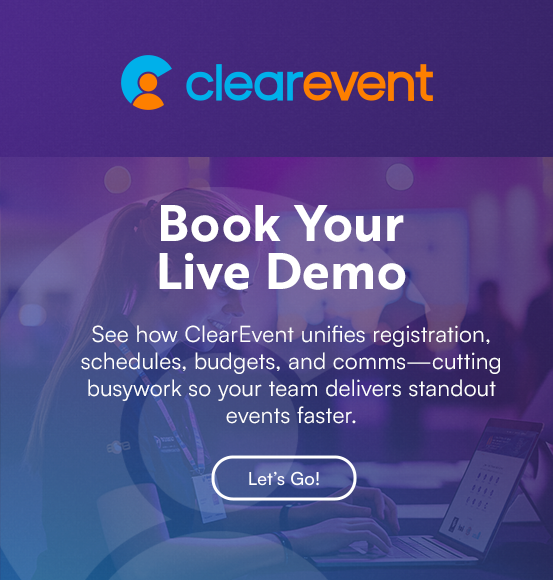How to Create Meaningful Networking Opportunities at Your Event

Ask any attendee why they come to an event, and chances are their top answer is simple: to make meaningful connections. That’s why creating structured networking opportunities is one of the smartest investments you can make.
Why Traditional Networking Falls Short
Classic networking activities like cocktail receptions or dinners can work for some, but they often leave others feeling overwhelmed, uncomfortable, or unsure how to break into conversations. When attendees are left to wander a crowded room, they may not meet the people most valuable to them, and no one wants to get stuck in a conversation that doesn’t feel productive.
These types of events also pose challenges for event budgeting and financial planning: food, beverage, and venue costs can rise quickly, and the return on investment may be hard to measure. If you need guidance, explore our blog on event budgeting strategies to better plan and control costs.
Beyond Social Mixers: Structured Networking
To create a stronger guest experience that feels welcoming, efficient, and memorable, you can consider structured networking formats. For example:
- Facilitated Roundtables: Group attendees by industry, interest, or role to help them connect with peers who share common challenges.
- Guided Icebreakers: Use short prompts or activities to ease attendees into conversations.
- Networking Breaks Built Into the Agenda: Instead of leaving networking to chance, carve out short, purposeful breaks for connection.
These formats not only keep costs predictable for expense tracking but also reinforce your marketing strategy by making networking a visible priority.
Speed Networking: A Proven Format
One of the most effective ways to maximize limited time is speed networking. Similar to speed dating, this structured approach pairs attendees for short, timed conversations before moving them on to the next person.
Why it works:
- Efficient: Attendees meet more people in less time.
- Inclusive: Even introverts or first-time attendees feel comfortable because everyone has equal time.
- Measurable: Organizers can easily track participation and follow-up connections.
This format is best placed early in the agenda, giving participants a set of warm introductions they can build on throughout the rest of the event.
Enhancing Networking with Technology
Modern events don’t need to rely solely on paper business cards and chance encounters. Technology can make networking smoother and more impactful:
- Digital Profiles & QR Codes: Replace paper cards with QR codes or in-app profiles so connections are easy to exchange and track.
- Smart Matching Tools: Use survey data from registration forms to group people by shared interests or goals.
- Real-Time Messaging: Allow attendees to follow up within your event portal, ensuring conversations continue beyond the initial introduction.
These tools help planners integrate networking into their broader marketing strategy while also providing data that supports expense tracking and financial planning.
Action Steps for Event Organizers
To improve your next event’s guest experience, try these steps:
- Budget Early: Include networking sessions in your event budgeting process so you allocate resources for meaningful connections.
- Plan Intentionally: Add structured networking into the agenda instead of leaving it up to social events.
- Track ROI: Use technology and feedback surveys to measure whether attendees found value in networking.
- Promote It: Highlight networking opportunities in your marketing strategy to attract attendees who see relationship-building as a key reason to attend.
Final Thoughts
Networking doesn’t need to feel stressful or left to chance. By using structured formats like speed networking, enhancing them with technology, and integrating them into your event management platform, you create stronger guest experiences and more measurable results.
When attendees leave with meaningful new connections, they’ll remember your event as a success and they’ll be more likely to return, recommend it, and support your future events.
Frequently Asked Questions (FAQ)
What is speed networking at an event?
Speed networking is a structured activity where attendees rotate through short, timed conversations. This format helps participants meet more people quickly and ensures everyone has equal opportunities to connect.
How can I include networking in my event budgeting?
When creating your event budget, allocate specific funds for structured networking activities like facilitated roundtables or speed networking sessions. Planning these costs early helps you balance financial planning and measure ROI more effectively.
What are the best ways to make networking less intimidating for attendees?
Offer guided icebreakers, small group sessions, or digital tools that match people based on shared interests. By creating structure, you reduce social pressure and make the guest experience more inclusive.
How can technology improve event networking?
Technology can simplify networking by providing QR codes, digital profiles, or in-app messaging. These tools not only make connecting easier but also give organizers valuable data for expense tracking and follow-up.
When should networking be scheduled during an event?
Networking works best early in the agenda so attendees can build on new connections throughout the event. Starting with a structured session also sets a welcoming tone and enhances overall guest satisfaction.
